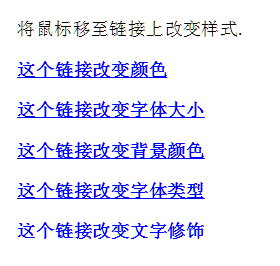《CSS 伪类》
CSS 伪类(Pseudo-classes)
CSS伪类是用来添加一些选择器的特殊效果。
语法
伪类的语法:
selector:pseudo-class {property:value;}
CSS类也可以使用伪类:
selector.class:pseudo-class {property:value;}
anchor伪类
在支持 CSS 的浏览器中,链接的不同状态都可以以不同的方式显示
菜鸟教程(runoob.com)
注意: a:hover 必须在 a:link 和 a:visited 之后,需要严格按顺序才能看到效果。
注意: a:active 必须在 a:hover 之后。
注意: 在CSS定义中,a:hover 必须被置于 a:link 和 a:visited 之后,才是有效的。
注意: 在 CSS 定义中,a:active 必须被置于 a:hover 之后,才是有效的。
注意:伪类的名称不区分大小写。
伪类和CSS类
伪类可以与 CSS 类配合使用:
a.red:visited {color:#FF0000;}
CSS 语法如果在上面的例子的链接已被访问,它会显示为红色。
CSS :first-child 伪类
您可以使用 :first-child 伪类来选择父元素的第一个子元素。
注意:在IE8的之前版本必须声明 ,这样 :first-child 才能生效。
匹配第一个
元素
在下面的例子中,选择器匹配作为任何元素的第一个子元素的
元素:
菜鸟教程(runoob.com)
This is some text.
This is some text.
注意:对于 :first-child 工作于 IE8 以及更早版本的浏览器, !DOCTYPE 必须已经声明.
匹配所有
元素中的第一个 元素
在下面的例子中,选择相匹配的所有
元素的第一个 元素:
菜鸟教程(runoob.com)
I am a strong man. I am a strong man.
I am a strong man. I am a strong man.
注意: 当 :first-child 作用于 IE8 以及更早版本的浏览器, !DOCTYPE 必须已经定义.
匹配所有作为第一个子元素的
元素中的所有 元素
在下面的例子中,选择器匹配所有作为元素的第一个子元素的
元素中的所有 元素:
菜鸟教程(runoob.com)
I am a strong man. I am a strong man.
I am a strong man. I am a strong man.
注意: 当:first-child 作用于 IE8 及更早版本的浏览器, DOCTYPE 必须已经定义.
CSS - :lang 伪类
:lang 伪类使你有能力为不同的语言定义特殊的规则
注意:IE8必须声明才能支持;lang伪类。
在下面的例子中,:lang 类为属性值为 no 的q元素定义引号的类型:
菜鸟教程(runoob.com)
Some text A quote in a paragraph
Some text.
在这个例子中,:lang定义了q元素的值为lang =“no”
注意: 仅当 !DOCTYPE 已经声明时 IE8 支持 :lang.
为超链接添加其他样式
菜鸟教程(runoob.com)
将鼠标移至链接上改变样式.
如何使用 :focus伪类
菜鸟教程(runoob.com)
注意:仅当 !DOCTYPE 已经声明时 IE8 支持 :focus.
所有CSS伪类/元素
| 选择器 | 示例 | 示例说明 |
|---|---|---|
| :checked | input:checked | 选择所有选中的表单元素 |
| :disabled | input:disabled | 选择所有禁用的表单元素 |
| :empty | p:empty | 选择所有没有子元素的p元素 |
| :enabled | input:enabled | 选择所有启用的表单元素 |
| :first-of-type | p:first-of-type | 选择的每个 p 元素是其父元素的第一个 p 元素 |
| :in-range | input:in-range | 选择元素指定范围内的值 |
| :invalid | input:invalid | 选择所有无效的元素 |
| :last-child | p:last-child | 选择所有p元素的最后一个子元素 |
| :last-of-type | p:last-of-type | 选择每个p元素是其母元素的最后一个p元素 |
| :not(selector) | :not(p) | 选择所有p以外的元素 |
| :nth-child(n) | p:nth-child(2) | 选择所有 p 元素的父元素的第二个子元素 |
| :nth-last-child(n) | p:nth-last-child(2) | 选择所有p元素倒数的第二个子元素 |
| :nth-last-of-type(n) | p:nth-last-of-type(2) | 选择所有p元素倒数的第二个为p的子元素 |
| :nth-of-type(n) | p:nth-of-type(2) | 选择所有p元素第二个为p的子元素 |
| :only-of-type | p:only-of-type | 选择所有仅有一个子元素为p的元素 |
| :only-child | p:only-child | 选择所有仅有一个子元素的p元素 |
| :optional | input:optional | 选择没有"required"的元素属性 |
| :out-of-range | input:out-of-range | 选择指定范围以外的值的元素属性 |
| :read-only | input:read-only | 选择只读属性的元素属性 |
| :read-write | input:read-write | 选择没有只读属性的元素属性 |
| :required | input:required | 选择有"required"属性指定的元素属性 |
| :root | root | 选择文档的根元素 |
| :target | #news:target | 选择当前活动#news元素(点击URL包含锚的名字) |
| :valid | input:valid | 选择所有有效值的属性 |
| :link | a:link | 选择所有未访问链接 |
| :visited | a:visited | 选择所有访问过的链接 |
| :active | a:active | 选择正在活动链接 |
| :hover | a:hover | 把鼠标放在链接上的状态 |
| :focus | input:focus | 选择元素输入后具有焦点 |
| :first-letter | p:first-letter | 选择每个 元素的第一个字母 |
| :first-line | p:first-line | 选择每个 元素的第一行 |
| :first-child | p:first-child | 选择器匹配属于任意元素的第一个子元素的 元素 |
| :before | p:before | 在每个 元素之前插入内容 |
| :after | p:after | 在每个 元素之后插入内容 |
| :lang(language) | p:lang(it) | 为 元素的lang属性选择一个开始值 |
笔记
伪类可以看作以选中元素为基准点,此元素的一些状态或属性。
chrome消除 div 滚动条的宽度,通过箭头键直接控制滚动:
#divContainer {
overflow: auto;
height: 160px;
width: 260px;
background-color:red;
}
#divContainer::-webkit-scrollbar {
border-width:1px;
}
在这里滚动鼠标
-------------
头部
123
123
123
-------------
123
123
123
123
-------------
123
123
123
123
-------------
123
123
123
123
123
-------------
123
123
尾部







